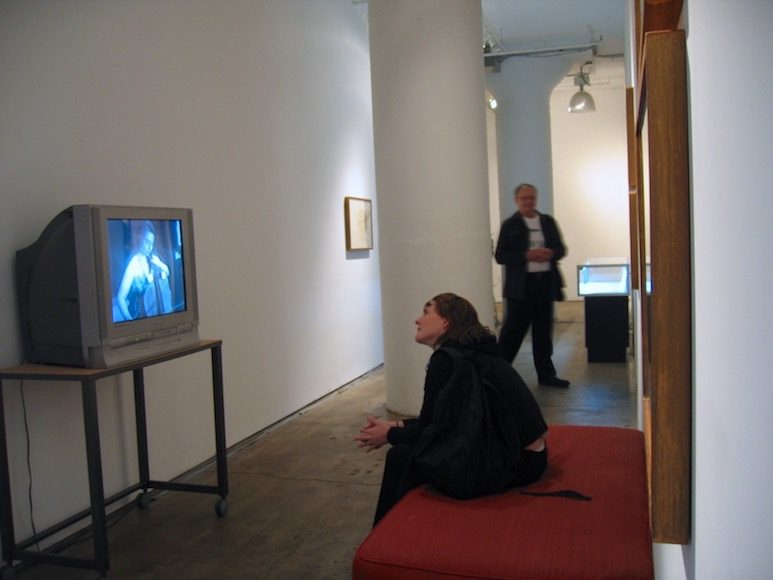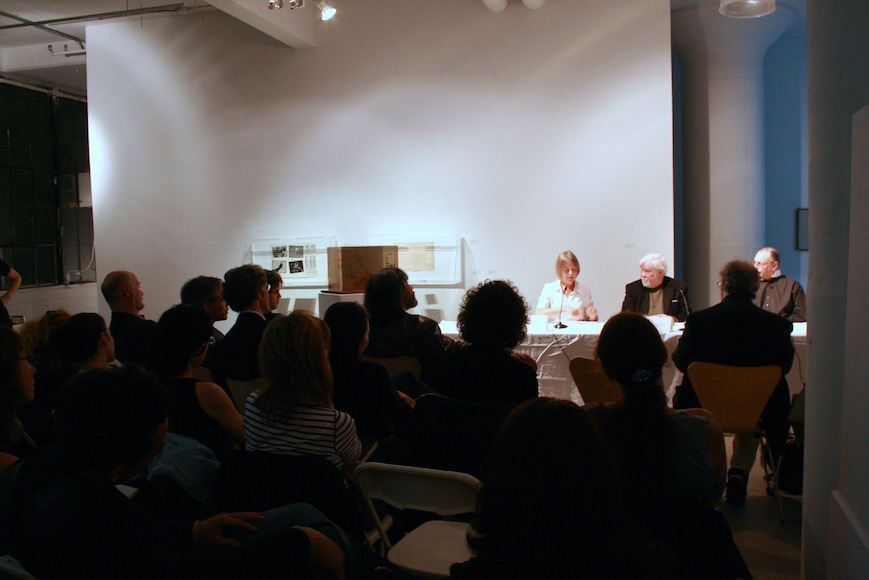Molly Davies
Molly Davies started making experimental films in the late 1960s in New York City. For multi media performance pieces she has collaborated with artists including John Cage, David Tudor, Takehisa Kosugi, Lou Harrison, Michael Nyman, Alvin Curran, Fred Frith, Suzushi Hanayagi, Sage Cowles, Polly Motley, Jackie Matisse and Anne Carson. Her work has been presented at such sites as the Venice Film Festival, the Centre Pompidou, Musee de l’Art Moderne de la Ville de Paris, Musee Art Contemporain Lyon, The Getty, Theatre Am Turm, the Whitney Museum, the Walter Arts Center, the Kitchen, La Mama Etc., Dance Theatre Workshop, Jacob’s Pillow Dance Festival and the Indonesian Dance Festival. Her work is in the collections of the Getty Research Institute, the Musee Art Contemporain Lyon and the Walker Art Center. She teaches courses in design for inter-media performances at universities in the United States, Europe and Asia.
Gary Hill
Gary Hill is one of the most important contemporary artists investigating the relationships between words and electronic images — an inquiry that has dominated the video art of the past decade. Originally trained as a sculptor, Hill began working in video in 1973 and has produced a major body of single-channel videotapes and video installations that includes some of the most significant works in the field of video art. His first tapes explored formal properties of the emerging medium, particularly through integral conjunctions of electronic visual and audio elements.
His installations and tapes have been seen throughout the world, in group exhibitions at The Museum of Modern Art, New York; Centre Georges Pompidou, Paris; Documenta 8, Kassel, West Germany; Long Beach Museum of Art, California; Stedelijk Museum, Amsterdam, and the Video Sculpture Retrospective 1963-1989, Cologne, West Germany, among other festivals and institutions. Hill’s work has also been the subject of retrospectives and one-person shows at The American Center, Paris; Whitney Museum of American Art, New York; 2nd International Video Week, St. Gervais, Geneva; Musee d’Art Moderne, Villeneuve d’Ascq, France; and The Museum of Modern Art, New York.
Gary Hill created new large scale works for his solo exhibition at the Fondation Cartier pour l’art contemporain in Paris, October 27, 2006 – February 4, 2007.
Jackie Matisse
Born in France, Jackie Matisse lived in New York until 1954. Since then she has lived in Paris making frequent visits to New York. Between 1959 and 1968 she worked for Marcel Duchamp, completing the assemblage of the “Boite en Valise”. At this time using her married name, Jacqueline Monnier, she began to make kites “in order to play with color and line in the sky”. In 1980 she showed kites which were created to be used underwater at the Betty Parsons Gallery in New York, and since then has continued to make kitelike objects intended for three different kinds of space: the sky, the sea, and indoor space, all linked through her use of movement.
George Quasha
Artist and poet George Quasha works across mediums to explore principles in common within language, sculpture, drawing, video, sound, installation, and performance. His axial stones and axialdrawingshave been exhibited in New York’s Chelsea at Baumgartner Gallery and ZONE Chelsea Center for the Arts, and elsewhere, and are featured in the newly published book, Axial Stones: An Art of Precarious Balance(Foreword by Carter Ratcliff) (North Atlantic Books: Berkeley).
For his video installation art is: Speaking Portraits (in the performative indicative),he has filmed some 500 artists, poets, and composers (in 7 countries and 17 languages) saying “what art is.” His video works (including Pulp Friction, Axial Objects, Verbal Objects) have appeared internationally in museums, galleries, schools, and biennials. A 25 year performance collaboration (video/language/sound) continues with Gary Hill and Charles Stein.
In 2006 he was awarded a Guggenheim Fellowship in video art.
His other 14 books include poetry (Somapoetics, Giving the Lily Back Her Hands,Ainu Dreams [with Chie Hasegawa],Preverbs); anthologies (America a Prophecy [with Jerome Rothenberg], Open Poetry[with Ronald Gross],An Active Anthology[with Susan Quasha], TheStation Hill Blanchot Reader); and writing on art (Gary Hill: Language Willing;with Charles Stein: Tall Ships, HanD HearD/liminal objects,Viewer).
Awards include a National Endowment for the Arts Fellowship in poetry. He has taught at Stony Brook University (SUNY), Bard College, the New School, and Naropa University. With Susan Quasha he is founder/publisher of Barrytown/Station Hill Press in Barrytown, New York.
Charles Stein
Charles Stein is the author of Persephone Unveiled (a study of the Eleusinian Mysteries), eleven books of poetry including The Hat Rack Treeand the forthcoming From Mimir’s Headfrom Station Hill /Barrytown, Ltd., a long-term poetic project, theforestforthetrees, translations of Greek epic, philosophical, and Hermetic poetry; a critical study of the poet Charles Olson and his use of the writings of C.G. Jung called The Black Chrysanthemum(also from Station Hill Press). His work has been anthologized in such collections as Poems for the Millennium (U. of California Press), Hazy Moon Enlightenment(Shambala),Technicians of the Sacred(U. of California Press),Text-Sound Texts(Morrow), Open Poetry(Simon and Schuster) and has appeared in such magazines as American Poetry Review, Alcheringa, Caterpillar, Conjunctions, Ear Magazine, Perspectives of New Music, Temblor, Sulphur, Open Space,and many other poetry journals. He was the editor of an anthology Being=Space X Action: Searches for Freedom of Mind in Art, Mathematics and Mysticism.
He received an Individual Writer’s Grant from the National endowment for the Arts for 1978-79, and was the winner of the Wallace Stevens Poetry Prize in 1973.
He plays Gregory Bateson in video-installation artist Gary Hill’sWhy Do Things Get in a Muddle?and is one of the two performers (with George Quasha) in Gary Hill’s Tale Enclosure. He collaborated with Gary Hill and Paulina Wallenberg-Olsson in the creation of Dark Resonances—a performance/installation at the Colosseum in Rome. For three decades he has worked with George Quasha in the production of “dialogical” critical texts, including three books: Hand Heard/liminal objects: Gary Hill’s Projective Installations—Number 1, Tall Ships: Gary Hill’s Projective Installations—Number 2,and Viewer: Gary Hill’s Projective Installations—Number 3.His other collaborative writing with George Quasha related to Gary Hill’s work has appeared in art catalogues of the Stedelijk Museum of Amsterdam, the Kunsthalle of Vienna, the Barbara Gladstone Gallery of New York, Public Access of Toronto, the Voyager Laserdisc Gary Hill, etc.
In collaboration with Gary Hill and George Quasha, he has performed at the Long Beach Museum of Art, California, The Museum of Modern Art, Oxford, England, The Rhinebeck Performing Arts Center.
As a multi-media artist and “Sound Poet” his graphic “Text-Sound Texts” have been anthologized and performed by himself and others; his drawings have appeared as accompaniments to his own poetry. He has performed his sound poetry at the International Sound Poetry Festival, The New Moon Festival, The New Image Theater, as well as at numerous University sponsored, music, and literary venues.
His photography has appeared in exhibitions at The College Art Gallery of SUNY New Paltz, The University of Connecticut Library in Storrs, The Arnolfini Arts Center in Rhinebeck, New York, the Robert Louis Stevenson School in New York, New York, and on the covers of numerous books of poetry and fiction.
He holds a Ph.D. in literature and has taught at SUNY Albany, Bard College’s Music Program Zero, and The Naropa Institute.
He currently resides in Barrytown, New York.



























